Dazzling Dioptase Crystals: The Emerald of the Mineral Kingdom
In the vast realm of the mineral kingdom, where every gem holds a story of earth’s artistry, there lies the enchanting Dioptase Crystal – a gem whose rich, emerald allure can captivate any onlooker at first glance. Often mistaken for the more famous emerald due to its brilliant green hue, Dioptase stands as a unique treasure, weaving tales of ancient times, mystical properties, and natural wonders.
Imagine, for a moment, a crystal so verdant it seems to encapsulate the essence of the deepest rainforests, or the vibrant spirit of spring’s fresh growth. That’s Dioptase for you – a testament to nature’s palette and prowess.
In this article, we’re about to embark on a shimmering journey, tracing the footsteps of this crystal from its rough origins to its radiant transformations. We’ll delve into its chemical makeup, explore the legends and lores surrounding it, discover the artisans who have mastered its intricate crafting, and even get hands-on with a fun DIY section. Ready to dive into the dazzling world of Dioptase? Let the adventure begin!
1. Dive into the Deep Greens: The Enigmatic Dioptase Crystals

Nature, in her infinite creativity, has birthed countless wonders, and nestled among them is Dioptase – a gem that seems to hold the very heartbeat of our lush, green planet. Let’s embark on an enlightening voyage to understand this radiant crystal’s makeup and the rich tapestry of its past.
A. Beneath the Lustrous Surface: The Structure of Dioptase
1. Chemical Composition and Crystalline Structure: Dioptase is a copper cyclosilicate mineral, boasting a formula of CuSiO₃·H₂O. It belongs to the hexagonal crystal system, which results in its often short, prismatic crystals. Its vibrant color comes from the presence of copper, lending it that signature emerald-like green hue.
2. A Game of Gemstone Doppelgängers: Comparing Dioptase to Other Stones: At first glance, the untrained eye might mistake Dioptase for the illustrious emerald or even the vibrant malachite due to its green brilliance. However, there are stark differences:
- Emerald: A member of the beryl family, it’s generally lighter in color and belongs to a different crystal system.
- Malachite: Also a copper carbonate mineral like Dioptase, malachite often has banding or circular patterns which distinguish it. While each green gemstone has its own beauty, Dioptase holds a singular allure that’s both deep and captivating.
B. The Ancient Echoes: History and Origins of the Name ‘Dioptase’
1. Tracing Back the Name: The term “Dioptase” is derived from the Greek words ‘dia’, meaning “through”, and ‘optos’, meaning “vision” or “sight”. This could allude to the crystal’s transparent nature and its radiant green hue which seems to beckon one to look deeper, almost as if peering through a window to nature’s soul.
2. Historical Significance and Uses: Dioptase has been revered since ancient times, not just for its beauty but also for its perceived metaphysical properties. Here’s a glance at its historical timeline:
- Ancient Egypt: Some scholars believe that Dioptase might have adorned the ornate jewelry and amulets of the pharaohs, given its resemblance to emeralds and the Egyptians’ penchant for green gemstones symbolizing rebirth and vitality.
- Greco-Roman Era: The ancients might have used the stone as an aid in vision and insight, aligning with the meaning of its name.
- Medieval Period: As trade routes expanded, the allure of Dioptase spread across continents, with apothecaries and mystics cherishing it for its purported healing properties.
Centuries may have passed, but the magic of Dioptase remains evergreen, shining a light on the timeless connection between humans and the wonders of the Earth.
2. The Power and Properties of Dioptase Crystals: A Gem Beyond Aesthetics
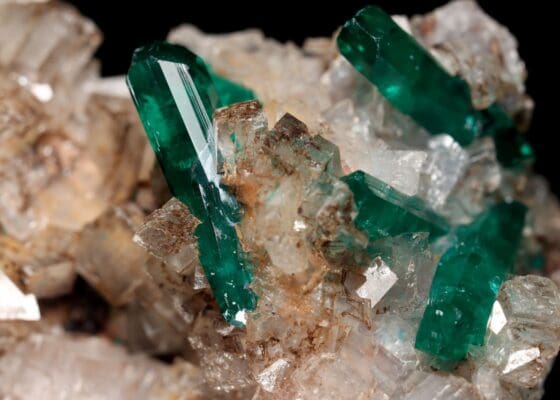
The radiant beauty of Dioptase, with its intense verdant hues, isn’t just a feast for the eyes. Beneath its luminous surface lies a world of powerful properties, both metaphysical and physical, making it a gem that truly resonates with many. Let’s unearth the depths of Dioptase’s significance.
A. Beyond the Eye: Metaphysical and Healing Potentials of Dioptase
1. The Pulse of the Heart Chakra: Emotional Healing with Dioptase
- The heart chakra, or “Anahata” in Sanskrit, is the energy center located near our heart, and Dioptase’s green hue deeply resonates with it. Working closely with this chakra, Dioptase can:
- Heal emotional wounds and help one to overcome bitter experiences.
- Rekindle feelings of compassion, love, and forgiveness, thus rejuvenating relationships.
- Enhance one’s capacity for empathy, allowing for a deeper connection with others.
2. Time-Travel with Dioptase: Past-Life Regression and Deep Trauma Healing
- Many crystal healers believe in Dioptase’s potential to aid individuals in accessing memories from past lives. This has implications in:
- Unearthing traumas and wounds that have carried over to this lifetime, thus facilitating deep healing.
- Helping one understand patterns or cycles in their life and finding ways to break or embrace them.
3. The Beacon of Insight: Dioptase for Mental Clarity and Spiritual Growth
- Nurturing the mind and spirit, Dioptase can serve as a catalyst for:
- Enhancing intuitive capabilities and fostering a more profound spiritual understanding.
- Clearing mental fog, allowing one to make decisions with greater clarity and foresight.
- Strengthening spiritual connections, aligning the soul with its higher purpose.
B. A Glimpse at Its Physical Grandeur
1. Standing the Test of Time: Dioptase on the Mohs Scale
- Dioptase scores a 5 on the Mohs hardness scale, making it moderately hard but somewhat delicate. This means while it’s resilient to some extent, it also needs careful handling to avoid scratches and damage.
2. Dances with Light: The Refraction and Twinkle of Dioptase
- One of the standout physical properties of Dioptase is its mesmerizing sparkle, stemming from its high refractive index. When light enters the crystal:
- It bends sharply, giving the stone its unique, radiant glow.
- The gem plays with light, breaking it in a way that illuminates its rich green tones, creating a visual symphony that captivates observers.
In essence, Dioptase isn’t just a visual marvel; it’s a stone that touches the heart, soul, and mind, making it a beloved gem for enthusiasts and healers alike.
3. World Tour: The Dioptase Trail
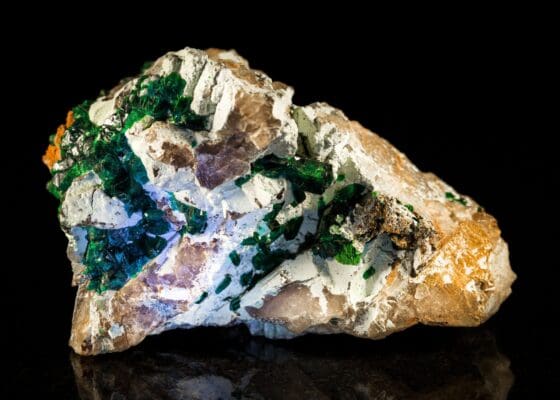
The allure of Dioptase isn’t merely restricted to its aesthetic and metaphysical properties. Part of its charm is its story, a tale that spans continents and echoes from the depths of our planet. Let’s embark on a journey across the globe, chasing the vivid trails of Dioptase.
A. Map Points: The Most Famous Dioptase Locations
1. Tsumeb, Namibia: The Jewel of Africa
- Nestled in the northern parts of Namibia, the Tsumeb mine is often referred to as a mineral mecca. Among its treasures is Dioptase.
- Unique Features: The Dioptase crystals here are celebrated for their intense color and pristine clarity. Many consider them to be the finest examples of the mineral.
- Historical Significance: The mine has been operational for over a century, with its Dioptase specimens being highly sought after by collectors.
2. Altyn-Tyube, Kazakhstan: The Eastern Emissary
- Located in the Karaganda Region, the Altyn-Tyube mine is another crucial point on the Dioptase map.
- Unique Features: While the crystals from here might be smaller in size compared to those from Tsumeb, they compensate with their vibrant hue and exceptional luster.
- Cultural Connection: The region reveres the stone, often associating it with local legends and folklore.
3. Copper Mines of Arizona and Chile: The Western Wonders
- The vast landscapes of Arizona and the rugged terrains of Chile have something in common: rich copper mines that also house Dioptase.
- Unique Features: The Dioptase from these regions often presents itself alongside other copper-based minerals, resulting in specimens that are a visual treat.
- Mining Marvel: The copper mines, especially in Arizona, are a favorite among mineralogists and gem enthusiasts, given the variety of treasures they yield.
B. The Tale of Terroir: Why Location Matters
Just as the quality of a wine is influenced by the region of its vineyard, the nuances of Dioptase are deeply tied to its place of origin.
1. Elemental Influence: The presence of various elements in a specific location can determine the crystal’s color intensity and clarity. For instance, higher copper concentrations can yield a deeper green.
2. Geological Conditions: The pressure, temperature, and surrounding rocks can influence the crystal’s formation, size, and overall structure. Some regions might produce larger but less clear crystals, while others could yield smaller, intensely colored ones.
3. Biotic Interactions: Fungi, bacteria, and organic matter play a role in mineral formation. The unique biodiversity of a region can subtly influence the mineral’s attributes.
4. Erosional Forces: Weathering patterns, including wind and water flow, can impact the crystal’s exterior appearance, its accessibility, and even its preservation.
In the grand tapestry of Earth’s narrative, every Dioptase crystal is a chapter, deeply influenced by its geographical setting, waiting to be read and revered by those who seek it.
4. From Rough Stone to Radiant Jewel: Dioptase’s Metamorphosis
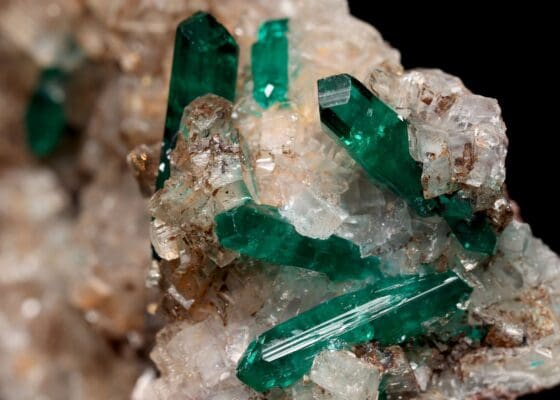
In the hands of a skilled artisan, raw materials transform into masterpieces. But when that material is as intricate and delicate as Dioptase, the artistry reaches new pinnacles. Dive with us into the fascinating process of turning this green wonder into a showstopper.
A. Navigating the Challenge: Crafting Dioptase
1. Delicacy in Every Grain: Dioptase, scoring a 5 on the Mohs scale, possesses a moderate hardness. However, its brittle nature makes it susceptible to cracks, fractures, and other damages. Craftsmen must exhibit exceptional skill, patience, and care while working with this gem, ensuring that its beauty is preserved, not compromised.
2. The Jewelry Dilemma: Given its delicate constitution, Dioptase isn’t a common choice for mainstream jewelry, especially pieces like rings or bracelets that are prone to knocks. However, its vibrant color has inspired artisans to craft unique jewelry items, like pendants or earrings, which are less exposed to potential damage.
B. A Cut Above: Dioptase’s Aesthetic Transformations
1. Shapes and Cuts:
- Cabochon: This is a popular choice for Dioptase, allowing the stone’s color depth and clarity to shine without the challenges of faceting.
- Faceted Cuts: While more challenging, some craftsmen do create faceted Dioptase gems, especially for earrings or pendants. These cuts maximize light reflection and play, giving the stone an alluring sparkle.
- Natural or Rough: Many collectors and jewelry enthusiasts love Dioptase in its raw, natural form, often set as statement pieces that celebrate its unaltered beauty.
2. Celebrating Mastery: While many artisans work with Dioptase, a few have achieved mastery, turning this gem into wearable art. These craftsmen not only possess technical prowess but a deep understanding of the stone’s essence. They often work hand in hand with miners to select the best specimens, and through their artistry, they narrate the crystal’s journey from the heart of the Earth to the soul of jewelry.
In the world of gem crafting, working with Dioptase is akin to a delicate dance, a balance of honoring its natural beauty while enhancing its visual appeal. Those who master this dance offer the world jewels that are not just accessories, but stories crystallized in time.
5. Caring for Your Dioptase Crystals: Guarding Nature’s Green Gem
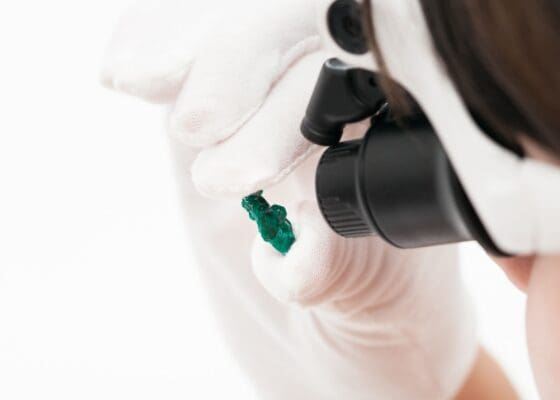
Dioptase, with its enchanting emerald hue, is undeniably captivating. But, as with many of nature’s treasures, this gem requires a tender touch. Let’s explore the ways to ensure your Dioptase stays as dazzling as the day it was crafted.
A. Shine On: Cleaning and Storing Your Dioptase
1. Gentle Cleaning Ritual:
- Lukewarm Soak: Immerse your Dioptase in lukewarm water with a few drops of mild soap. Avoid using hot or cold water as sudden temperature changes can cause fractures.
- Soft Brushing: Gently brush the stone with a soft-bristled brush to remove any accumulated dirt or oils.
- Pat Dry: Use a soft, lint-free cloth to dry the gem. Ensure it’s thoroughly dry before storing to prevent any moisture damage.
2. Storage Secrets:
- Individual Pouches: Store your Dioptase in a soft pouch or a jewelry box with individual compartments. This prevents scratches and ensures the gem isn’t subjected to any unnecessary pressure.
- Away from Sunlight: While a bit of sun can enhance its vibrancy temporarily, prolonged exposure can fade its color. It’s best to store it away from direct sunlight.
- Humidity Watch: Keep your Dioptase in a place with consistent humidity, as too much can lead to tarnishing, especially if the gem is set in certain metals.
B. Safeguarding the Gem: Hazards to Watch Out For
1. Chemical Caution:
- Daily Products: Everyday items like perfumes, lotions, or hairsprays can contain chemicals that may dull the gem’s surface. Always wear your Dioptase jewelry last after applying these products.
- Cleaning Agents: Avoid cleaning solutions that contain harsh chemicals or abrasives. Always opt for mild, gem-friendly solutions.
2. Temperature Tidbits:
- Avoid Extremes: Exposing Dioptase to extreme temperatures or sudden temperature shifts can result in internal fractures or surface cracks. Keep it away from heaters, air conditioners, or direct freezer blasts.
- Steam & Ultrasonic Cleaners: These popular jewelry cleaning methods are a no-go for Dioptase due to the gem’s delicate nature and potential vulnerability to temperature changes.
Cherishing your Dioptase means more than just adoring its beauty; it involves understanding its needs and offering it the care it deserves. In doing so, you not only preserve its physical allure but also honor the millennia of Earth’s history it encapsulates.
6. Dioptase Crystals in Pop Culture and Mythology: An Ageless Green Star
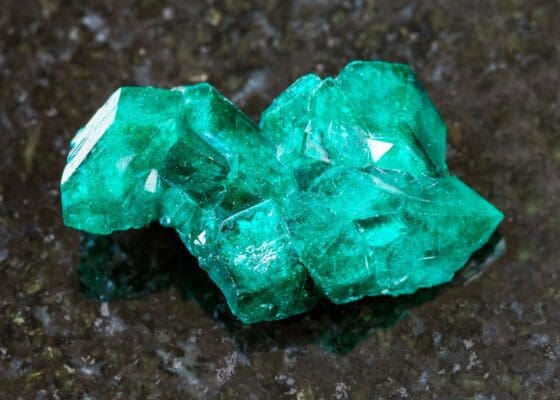
From ancient whispers to modern spotlights, Dioptase has undeniably carved a space for itself in the hearts and stories of many. Whether enshrined in ancient myths or gleaming from the neck of a contemporary icon, this green gem has played myriad roles in the cultural tapestry of our world.
A. Echoes from the Past: Myths, Legends, and Dioptase’s Stardom
1. Tales from Ancient Cultures:
- Guardian of Lost Souls: In certain ancient cultures, Dioptase was believed to be a beacon for lost souls, guiding them to the afterlife or helping them find rebirth. Its deep green was symbolic of the verdant lands beyond.
- Healing Elixirs: Shamans and healers would often grind Dioptase into powders, incorporating them into healing potions, believing the stone could heal both the body and the spirit.
2. Literature and Film:
- Novels of Enchantment: While not always explicitly named, gemstones resembling Dioptase’s vibrant hue have made appearances in fantasy literature as talismans of power or objects of quests.
- Cinematic Symbolism: In film, a Dioptase-like gem might represent a character’s connection to their past, echoing the stone’s supposed ability to help access past life memories.
B. The Modern Stage: Dioptase in the Contemporary Spotlight
1. Celebrity Admirers:
- Famous figures, from pop stars to Hollywood elites, have occasionally been spotted donning Dioptase jewelry, especially during events where unique and rare gemstones are celebrated.
- Artisans and jewelers catering to the A-list often incorporate Dioptase in bespoke pieces, playing up its rarity and vivid color.
2. Cultural Rebirth and New Age Movements:
- With the rising interest in crystal healing and metaphysics, Dioptase has found renewed significance among spiritual seekers and new age enthusiasts.
- Its reputed connection to heart chakra healing, past life regression, and emotional wellness has led to its frequent mention in modern holistic literature and media.
3. Art and Exhibitions:
- World-class museums and gem exhibitions often feature Dioptase for its historical significance and sheer beauty. These displays serve as educational platforms, narrating the gem’s journey from its ancient roots to its modern renditions.
Tracing the cultural journey of Dioptase is akin to traversing a lush, green forest – there are twists, turns, shadows, and gleaming sunlit clearings. Its story is as multi-faceted as the gem itself, ever-evolving, and waiting for the next chapter to unfold.
Conclusion: Dioptase Crystals- A Gem of Timeless Beauty and Resonance
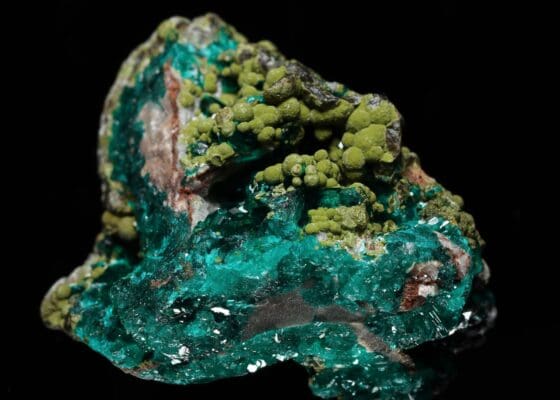
As we journey back from the depths of the Earth’s cradle, through the annals of history, the artisans’ ateliers, and the glamorous showcases of pop culture, one truth remains unerring: Dioptase, with its radiant emerald hue, is a gem of incomparable allure and meaning.
Its story isn’t just in the vibrant color or its intricate crystalline structure; it’s woven into the tapestry of human history, culture, and even our spiritual pursuits. This gem stands as a testament to nature’s artistry and the deep, enduring connections between the Earth and its inhabitants.
But to truly understand and appreciate the magic of Dioptase, one cannot merely read or hear about it. Its beauty demands to be seen, its energy to be felt. So, whether you’re a collector, a spiritual seeker, a jewelry enthusiast, or someone simply captivated by the wonders of the world, seek out this green marvel. Hold it, admire it, and let its millennia-old stories whisper to you.
Remember, the world is filled with wonders, but some, like Dioptase, are rare treasures that deserve a special place in our hearts and our narratives. Embark on your journey with this gem and discover a story that is as unique as you are.
Interactive Segment: Dioptase Quiz!
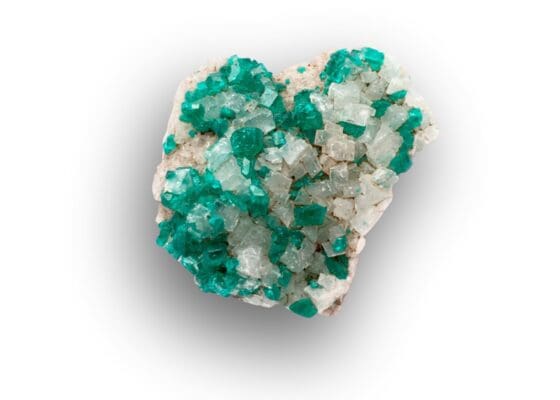
So, you’ve journeyed through the captivating world of Dioptase. Think you’ve mastered its secrets? It’s time to test your knowledge with this interactive quiz!
1. What hue is Dioptase best known for?
- A) Ruby Red
- B) Golden Yellow
- C) Bright Emerald Green
- D) Deep Blue Sapphire
2. Where is one of the most famous locations to find Dioptase?
- A) Paris, France
- B) Tsumeb, Namibia
- C) Cairo, Egypt
- D) Sydney, Australia
3. Which chakra is Dioptase commonly associated with?
- A) Crown Chakra
- B) Solar Plexus Chakra
- C) Sacral Chakra
- D) Heart Chakra
4. On the Mohs scale, how hard is Dioptase?
- A) 5-6
- B) 7-8
- C) 3-4
- D) 9-10
5. Why isn’t Dioptase typically used for mainstream jewelry?
- A) It’s too common.
- B) It’s too hard to cut.
- C) It’s too expensive.
- D) Its delicate nature.
6. Dioptase can help with what kind of healing?
- A) Past-life regression
- B) Amplifying energy
- C) Enhancing physical strength
- D) Improving communication
Answers:
- C – Bright Emerald Green
- B – Tsumeb, Namibia
- D – Heart Chakra
- A – 5-6
- D – Its delicate nature
- A – Past-life regression
End Note: Whether you aced the quiz or learned something new, remember that the world of crystals and gemstones is ever-expanding. Keep your curiosity alive and continue to explore the fascinating tales and traits of nature’s treasures. And who knows? Maybe Dioptase has a special message or lesson waiting just for you!

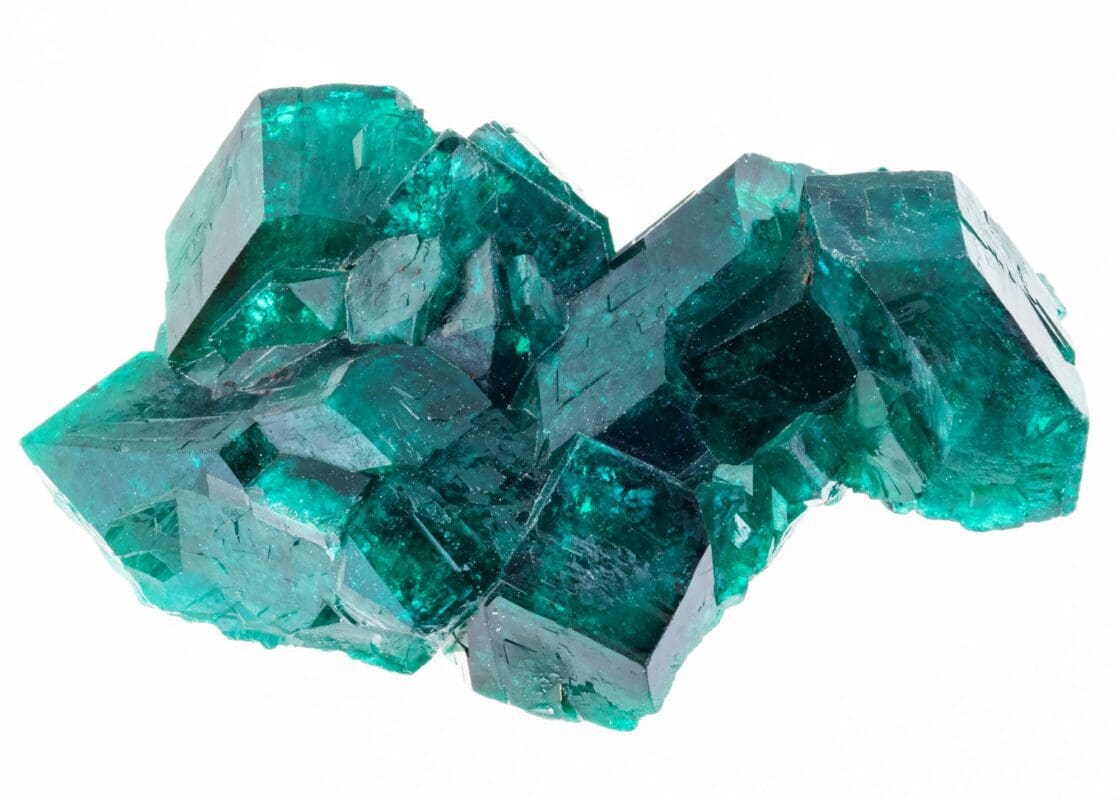
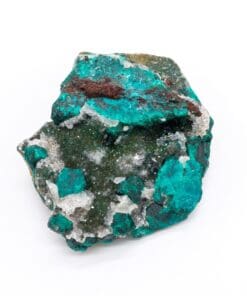
Grazie mille per informazione ne ho. 7 etti. Meravigliosi regalati. 50 anni fa da. Un. Diplomatico. Vissuto. In. Kenia. Volevo. Venderlo. …..ma dopo.avermi. Informato. Li tengo